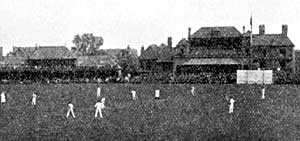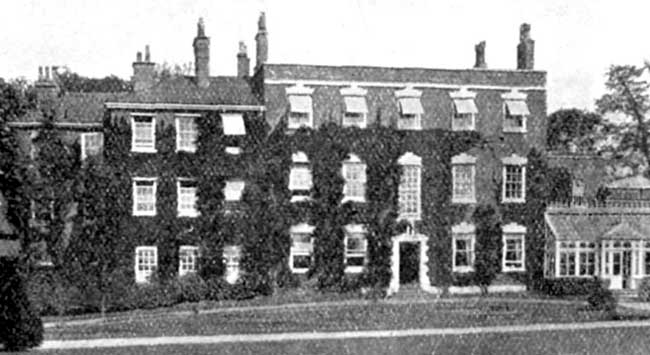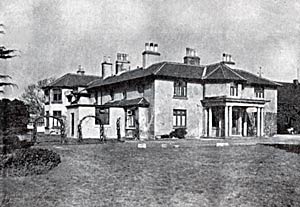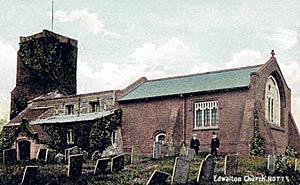
Cricket Ground. The earliest reference to cricket in Nottingham appears to have been on August 26th, 1771, in a match against Sheffield. In 1789 Nottingham played Leicester at Loughborough, the return match being on November 2nd.
The Nottingham Town Cricket Ground was on the Forest, on land adjoining to the Race Stand, but Orange's "History," published in 1840, says "Mr. Clarke has recently established a cricket ground at the Trent Bridge Inn " (page 946). This ground was, according to an article in the "Westminster Gazette," opened by William Clarke in 1839, and he remained the proprietor of it until 1847. The opening inter-county match was at Trent Bridge ground on July 27th, 1840, on which occasion Sussex won by fourteen runs.
The date of the formation of the Notts. County Cricket Club is not clear, but according to Richards' Cricket Guide, "in 1864 the Nottingham County Club had about 300 members, who annually subscribed from 10/- upwards." In the early days the players were attired in tall white hats, high stand-up collars, braces across the shoulders, and sometimes knee breeches and silk stockings.
The old Trent Bridge Inn, when kept by Clarke, was a very small and plain building, with the peculiarity that it stood in two parishes, the front being in Nottingham, and the kitchen in Bridgford, causing the Mickletorn Jury, in beating the boundaries, to have to climb through the kitchen window, a feat for the stout men to accomplish. The present Inn was set back, and is wholly is Bridgford. For many years the only pavilion was the small, red-brick, one storey building, at the back of the present Inn. In 1872 a new pavilion was erected at a cost of £1,500, which encroached too much on the ground, and was afterwards pulled down. Mr. William Wright, in 1884, negotiated with Mr. J. C. Musters, the owner of the property, and obtained a lease for 99 years of the Inn and grounds (101/2 acres), which was granted to three gentlemen for the benefit of the Club, they being Captain Tomasson, and Messrs. Wm. Hollins and C. W. Wright. A new pavilion was erected at a cost of £5,000, and a sub-lease of the Inn for the term of 33 years was in 1897 sold by the Trustees for a premium of £4,000, and subject to an annual rental. Mr. Turner was in that year appointed Secretary, the club then having 1,050 members, and being in debt £5,400, £4,000 of which was wiped off by the transaction referred to. The Ladies' Pavilion, and covered stands, were erected in 1898, at a cost of £7,000.
A circular was in April, 1914, issued by the Duke of Portland, stating that the Club, through the provision of additional stand accommodation, annual deficits, and the Players' Benefit Fund, was in debt to the extent of £5,600.
The normal expenditure was £4.300, and the income consisted of subscriptions £2,454; Gate money, rents, etc., £1,700. A subscription was thereupon made, and over £4,000 received by donations. Sir Jesse Boot is the President for the year. The number of members is now 2,400. Two quotations given in the Duke's circular are worth copying. They are as follows :—
- The Hon. Robert Lyttelton writes:—"No County in England has had so glorious a cricket history as Notts. During the last twenty years its supremacy has been seriously challenged, very largely because Notts, and Yorkshire alone among all the Counties have been proud of their history, and have steadily refused to import any players from outside, but have relied wholly on their native talent."
- A great lover of Notts, cricket, the Hon. Chandos Leigh, wrote: ''There must be a larger percentage of cricketers in Notts, than can be found anywhere. The population of Notts, is 600,000, a less number than can be found in Leeds and Bradford, only two towns in Yorkshire.'' "All honour to the County which can still hold her own without ever going outside her own borders."
Among the famous cricketers who have been locally bred, and have played on the ground may be named: William Clarke, who was the most celebrated slow bowler of his day; he made his debut for Nottingham in a game in 1817; in 1846 he formed his famous All England XI., and toured the country. He continued playing till he was quite an old man. Samuel Redgate, of Arnold, fast bowler, was considered the best bowler in England. Richard Daft, of Radcliffe, the graceful batsman, was one of the most prominent of the Notts. Eleven. George Parr, also of Radcliffe, was premier batsman of his day. Joseph Guy, of Nottingham, played in the Gentlemen v. Players matches fifteen years without intermission.
Alfred Shaw is described by Lord Harris as "the greatest of all medium-paced bowlers." Lord Sheffield speaks of the life of an honest, straight-forward, manly Englishman, as well as a splendid cricketer, whose name will never be forgotten. Mr. W. F. Grundy has written a "Memento of Arthur Shrewsbury and Alfred Shaw," and referring to the number of Shaw's balls, he says "During the delivery of this immense number of balls Alfred Shaw did not bowl one wide, and only one or two no-balls, showing the absolute control he had over the ball" (page 90).
Arthur Shrewsbury played for twenty-eight years in first-class matches, and scored 26,199 runs, which included sixty centuries, ten of these being of 200 and over. He and Shaw took out four teams to Australia. Lord Harris says:— "Arthur Shrewsbury * * * one of the best batsmen for all time, made four hundreds against the Gentlemen, two at Lord's, and two at the Oval. His career, like Parr's, was long and brilliant, and the fact that his batting was modelled partly on Daft's, accounts for the ease and finish of his style. He was an admirable judge of the length of bowling, and could probably watch the ball closer to the bat than any of his contemporaries, while for soundness of defence, coupled with inexhaustible patience, as well as for skill on sticky wickets, he was unrivalled. Lord's and the M.C.C., p. 282.
A goodly number of players must be mentioned with pleasure and approval, and among them are: Jarvis, Scotton, Wm. Oscroft (who hit a ball over the big elm called "George Parr's tree," 135 yards), Selby, Sherwin, Flowers, Barnes, Grundy. Jackson, Geo. Wootton, McIntyre, Wild, Bignall, Fred Morley, Tom Wass (who has taken more wickets in the County than any other bowler), William Gunn (who was the greatest batsman of his day, and made over thirty centuries), Attewell (who has many times rendered invaluable assistance to his side), and many others. Great credit must be given to the late Captain Holden, and to Captain Tomasson, for their services as Honorary Secretaries. Mr. J. A. Dixon and Mr. A. O. Jones will always be remembered as "skippers," the latter having scored more runs to the county than any other batsman; and it is worth recording that Harry Coxon is in his forty-fourth year of scoring, which is probably unique in county cricket.
Notts, has been Champion County in 1873-5-9, 1880-2-3-4-5-6-9 and 1907. To the credit of Notts., and also of Yorkshire, it can be claimed that, with rare exceptions, every man who has found a place in the respective teams has been a native.
In "The Kings of Cricket," by Richard Daft (p. 274) may be seen the portraits of eighty well-known cricketers, including many local ones. In "Lord's and The M.C.C.," a book costing 31/6, a reference is given, on p. 285, to the prominent part taken by Notts, men in 1892, and the scores of Gunn, Shrewsbury, Barnes and Attewell are given, with Sherwin as wicket-keeper, and it adds, "Seldom indeed has any county possessed five such great contemporaneous cricketers."
Athletics. Boots Athletic Club occupies grounds of 103/4 acres between Holme Road and the Trent. There are 496 members, who are all employed in some of the seven departments of business of the Company. The Club founded in 1892 by Sir Jesse Boot for the workpeople, comprises Cycling, Cricket, Football, Fishing, Hockey, Swimming, Rifle, Tennis, Bowls, Quoits, Skittles, Singing, Photography, etc. The subscriptions, which go to the provision of the games, are—3/6 for seniors, and 2/6 for juniors.
Boots' Girls' Athletic Club has 540 members, and their games comprise Hockey, Tennis, Cricket, Rounders, Basketball, Swimming, and a Gymnasium. The ground is rented from the Bridgford estate by Sir Jesse Boot. All employees of the Company are eligible for membership, none are required to join, and only those who pay the subscription are admitted.
The Young Men's Christian Association Athletic Ground —West Bridgford branch—embraces a Tennis Club, a Cricket Club, Hockey, three Billiard teams, an Institute, Refreshments, a Bible Class, etc.
The Trent Bridge Bowling Club owns its grounds adjoining to the Church. There are eighty members, who pay a guinea a year.
The Rowing Clubs are the Nottingham Britannia, the Nottingham Rowing, and the Nottingham Boat Clubs.
The Tennis Clubs include the "Riverdale," and the "Riverside."
The Nottingham Amateur Cricket Club has grounds adjoining to the Y.M.C.A.
The Nottingham Forest Football Club has its grounds south of the Trent, but just outside the parish, as are several of the other societies named. The club was formed in 1865, by a number of young men who previously played "Shinty" on the Forest—hence the name. The ground is leased from the Nottingham Corporation, and was opened in 1898, just after the club had won the English Cup. The accommodation is for 40,000 spectators, and cost several thousands of pounds.

West Bridgford Hall.
The Hall. The Hall, Captain Barker informs us, was begun to be built by Mundy Musters, Esq., in or about 1708, and was continued in an unfinished state until 1774, when it was finished by John Musters, Esq. It has, however, been considerably enlarged, and the grounds extended by the present owner, Albert Heymann, Esq., J.P.
Miss Chaworth—Lord Byron's Mary—is said to have first met with Mr. Musters (of Colwick, whom she afterwards married) at West Bridgford Hall.
Trees. There are few fine old trees in the parish. There are, however, a few of elm, oak, ash, and willow scattered in various parts of the parish. What is lacking in age, and size, will be made up by time, for in nearly every street in the parish trees are planted, and not less than 1,500 are under the care of the public authority. The varieties are lime, silver birch, elm, plane, sycamore, etc. A greater variety is desirable, as the interest would thereby be increased, and attention will doubtless be given to lopping, so as to prevent the trees growing too tall, and lanky. A part of the healthiness of the parish is due to its many trees. A curiosity may be seen in Mr. Simons' garden, where he has trained young oaks to form an arch over a garden path, and circles entwined, and to form one tree above the arch.
Wants. The provision for the public convenience is such that one would suppose there was nothing lacking, but here as elsewhere, much would have more. Among the things mentioned is the want of a public library. Apparently, Mr. Carnegie's offer of £3,000, which was rejected by vote in 1905, should be reconsidered. A Recreation ground in the southern part of the parish is named. Seats in the streets, and especially in the two unnamed squares, or centres, and where junctions are formed on the Bus routes, are desired. Strangers tell of the difficulty of finding streets for want of more name-plates, and of houses for want of distinct numbers, plainly affixed; and the lack of public sanitary conveniences is also mentioned.
We have now surveyed West Bridgford in relation to its past history, and present state. We have noticed its houses with gardens attached, in which are shrubs, fruits and flowers; it roads, adorned with trees of varied kinds; its administration, with every provision for health, convenience and comfort without the demoralization resulting from public-houses; its schools, in which air, light, training, culture, and development have been, and are studied and thought out by men and women who are devoted to their work; its social institutions, promotive of neighbourly feeling and cheerful exercise; its religious provision for the honour of God, and the salvation of men, in which there is a noble band of men and women workers whose hearts God has touched with sympathy, and whose lives are consecrated to the noblest of purposes; and looking around we exclaim "Bridgford is a place of which we may be proud, an honour to have a hand in its governance; a garden city which other places may with advantage copy, and from which shall go forth a noble band of young people to bless the world."

Adbolton Hall, c.1930.
Adbolton. Adbolton was, according to Dr. Thoroton, a part of the parish of West Bridgford. It is now a part of Holme Pierrepont. It was once a separate parish, and had at the time of the Conquest a church, and Godwin the priest had land, but in 1559 there was no priest, and the churchwardens reported: "No service thar thies too yeres." Thomas Rose, a minister ejected from Blidworth in 1662 under the act of uniformity, removed to Nottingham, where he was imprisoned six months, and upon his release he lived at Adbolton, where he preached to a considerable number of persons, but afterwards "he and many others were clapped up in prison." The church was taken down in 1746, for it had become entirely disused, and the stone was removed to repair Holme Pierrepont Church, and the farm houses of Adbolton and Gamston. In 1834 the site of All Saints' Church was levelled, and now forms part of Mr. Hickling's grounds, with no traces left except stones, etc., found in digging.
Gamston. Gamall, meaning "the old," may have come from Scandinavia, and settled at the time that the Danes governed Notts., and so have given his name to the hamlet—Gamelstune—afterwards called Gamston. Professor Stenton suggests that he lived about 880—900, and replaced some Englishman formerly owning the town, whose name has gone.
In 1086 there were two sochmen (ordinary tenants) who had six bovates (?90 acres) of land assessed. For several hundred years in the twelfth to the fifteenth century, the Luterels, who were Lords of Gamston and Bridgford, appear to have lived in the manor house. The present house, now occupied by Mr. Elnor, has a variety of stones, some being from Gedling quarry, and others of a prior building, testifying to its age. One hundred years ago Gamston always paid one-third of the annual expenses of Bridgford Church, there being about half the population of Bridgford, but the number has declined from 124 to 74.

Edwalton church, c.1905
Edwalton. Edwalton, meaning the tun or farm of Edweald (Mutschmann) is so intimately connected with Bridgford that a few notes must here be given, especially as it will help the Bridgford boys and girls to understand what is under their feet. Several years ago there was a boring for coal in the valley south of the Melton Road, and after going through 750 feet of marl, gypsum, sandstone, etc., a bed of coal, called Dunsil, was reached, and between that seam and a depth of 1,500 feet, to which the borings were sunk, twenty-one beds, or strips of coal, mostly thin ones, were passed through. Each of those strips tells us that which is now 750 to 1,500 feet below, was once upon a time the surface where vegetation grew. In Saxon times Countess Gode had land here. The Church was dedicated to St. Lawrence, but is usually called the Church of Holy Rood—or Holy Cross. The nave dates from the twelfth century, the roof and leads bearing date 1716. Lead was stolen from the church in 1824. The tower was built in the reign of Queen Mary. In 1227 the Archbishop of York directed the Rector of Flaufor (Flawforth) to do service in the Chapel at Edwalton on four days a week, and the Lord of Edwalton and his men to endow the chapel with two bovates (?30 acres) of land, with meadow, etc. The church was given to Beauchief Abbey, in Derbyshire, by Robert FitzRalph, who was Sheriff of Notts. and Derbyshire in 1165-8. It is usually believed that he was an accomplice of the four knights implicated in the murder of Thomas a Becket in 1170, who were Fitzurse, Tracy, Brito, and Morville. The gift (possibly in expiation), was in 1183, and in 1316 Edward II. confirmed it. The church was restored in 1881, and the chancel rebuilt in 1894. The parish schoolroom was built in 1896. Throsby, in 1790, says there were then thirteen farms in the parish. There are not half that number now. The land, he says, had been so boggy and indifferent, that it could scarcely be let at any price, but was then much improved. Better cottages for labourers are now sorely needed, for many cottages have been pulled down, as also the Hall, which stood in Hall Close. The population is 205.
